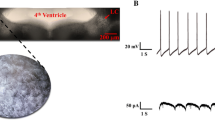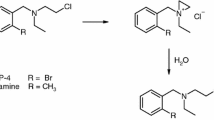Considering that noradrenergic (NAE) neurons of the locus coeruleus (LC) play significant roles in the formation of biological rhythms, pain, addictions, and mood disorders, we tested the effects of acute intracerebroventricular microinfusions of bupropion, an inhibitor of NA reuptake used in clinics as an antidepressant, on background spike activity on LC neurons in chloral hydrate anesthetized rats. Ten microliters of the solutions containing 0.001, 0.01, 0.1, 1.0, or 10.0 μmol bupropion were infused during 3 min; spike activity of single LC neurons identified according to the known characteristics was recorded extracellularly by glass microelectrodes. Microinfusions of 0.01 to 10.0 μmol bupropion suppressed background spiking of the above neurons in a dose-dependent manner. The normalized mean intensities and durations of inhibition were 17.3, 19.4, 26.3, and 41.1% and 1.4, 7.1, 12.4, and 18.3 min, respectively. The smallest dose (0.001 μmol) was ineffective. It is assumed that bupropion increases the NA level in proximity to NAE LC neurons. The actions of bupropion on other cerebral neuromodulatory systems need further examination. Inhibition of LC neuronal activity by bupropion can help to explain some acute, chronic, and side effects of this agent used in clinics for correction of mood disorders.
Similar content being viewed by others
References
E. Szabadi, “Functional neuroanatomy of the central noradrenergic system,” Psychopharmacology, 27, 659–693 (2013).
J. J. Schildkraut, “The catecholamine hypothesis of affective disorders. A review of supporting evidence,” Int. J. Psychiat., 4, 203–217 (1967).
W. Potter, G. Grossman, and M. Rudorfer, “Noradrenergic function in depressive disorders,” in: Biology of Depressive Disorders, J. Mann and D. Jupter (eds.), Plenum Press, New York (1993), pp. 1–27.
W. Kostowski, “Possible relationship of the locus coeruleus-hippocampal noradrenergic neurons to depression and mode of action of antidepressant drugs,” Pol. J. Pharmacol. Pharm., 37, 727–743 (1985).
P. L. Delgado, “Depression: the case for a monoamine deficiency,” J. Clin. Psychiat., 61, Suppl. 6, 7–11 (2000).
W. E. Bunney Jr. and J. M. Davis, “Norepinephrine in depressive reactions. A review,” Arch. Gen. Psychiat., 13, 483–494 (1965).
R. M. Hirschfeld, “History and evolution of the monoamine hypothesis of depression,” J. Clin. Psychiat., 61, Suppl. 6, 4–6 (2000).
G. A. Ordway, K. S. Smith, and J. W. Haycock, “Elevated tyrosine hydroxylase in the locus coeruleus of suicide victims,” J. Neurochem., 62, 680–685 (1994).
V. Chan-Palay and E. Asan, “Quantitation of catecholamine neurons in the locus coeruleus in human brains of normal young and older adults and in depression,” J. Comp. Neurol., 287, 357–372 (1989).
M. M. Grant and J. M. Weiss, “Effects of chronic antidepressant drug administration and electroconvulsive shock on locus coeruleus electrophysiologic activity,” Biol. Psychiat., 49, 117–129 (2001).
C. H. West, J. C. Ritchie, K. A. Boss-Williams, and J. M. Weiss, “Antidepressant drugs with differing pharmacological actions decrease activity of locus coeruleus neurons,” Int. J. Neuropsychopharmacol., 12, 627–641 (2009).
C. H. West, J. C. Ritchie, and J. M. Weiss, “Addendum: Paroxetine-induced increase in activity of locus coeruleus neurons in adolescent rats: implication of a countertherapeutic effect of an antidepressant,” Neuropsychopharmacology, 35, 1836–1837 (2010).
B. R. Cooper, C. M. Wang, R. F. Cox, et al., “Evidence that the acute behavioral and electrophysiological effects of bupropion (Wellbutrin) are mediated by a noradrenergic mechanism,” Neuropsychopharmacology, 11, 133–141 (1994).
Y. Mateo, J. Pineda, and J. J. Meana, “Somatodendritic alpha2-adrenoceptors in the locus coeruleus are involved in the in vivo modulation of cortical noradrenaline release by the antidepressant desipramine,” J. Neurochem., 71, 790–798 (1998).
S. Amirabadi, F. Ghaderi Pakdel, P. Shahabi, et al., “Microinfusion of bupropion inhibits putative GABAergic neuronal activity of the ventral tegmental area”, Basic Clin. Neurosci., 5, 182–190 (2014).
G. Paxinos, and C. Watson, The Rat Brain in Stereotaxic Coordinates, Acad. Press Inc., San Diego (2007).
J. Pineda, L. Ugedo, and J. A. Garcia-Sevilla, “Stimulatory effects of clonidine, cirazoline and rilmenidine on locus coeruleus noradrenergic neurones: possible involvement of imidazoline-preferring receptors,” Naunyn Schmiedebergs Arch. Pharmacol., 348, 134–140 (1993).
G. Aston-Jones and F. E. Bloom, “Norepinephrinecontaining locus coeruleus neurons in behaving rats exhibit pronounced responses to non-noxious environmental stimuli,” J. Neurosci., 1, No. 8, 887–900 (1981).
M. K. Borsody and J. M. Weiss, “Influence of corticotropin-releasing hormone on electrophysiological activity of locus coeruleus neurons,” Brain Res., 724, 49–68 (1996).
S. L. Foote, G. Aston-Jones, and F. E. Bloom, “Impulse activity of locus coeruleus neurons in awake rats and monkeys is a function of sensory stimulation and arousal,” Proc. Natl. Acad. Sci. USA, 77, 3033–3037 (1980).
J. Korf, B. S. Bunney, and G. K. Aghajanian, “Noradrenergic neurons: morphine inhibition of spontaneous activity,” Eur. J. Pharmacol., 25, 165–169 (1974).
G. K. Aghajanian and C. P. VanderMaelen, “Alpha 2-adrenoceptor-mediated hyperpolarization of locus coeruleus neurons: intracellular studies in vivo,” Science, 215, 1394–1396 (1982).
J. M. Cedarbaum and G. K. Aghajanian, “Noradrenergic neurons of the locus coeruleus: inhibition by epinephrine and activation by the alpha-antagonist piperoxane,” Brain Res., 112, 413–419 (1976).
P. E. Simson and J. M. Weiss, “Alpha-2 receptor blockade increases responsiveness of locus coeruleus neurons to excitatory stimulation,” J. Neurosci., 7, 1732–1740 (1987).
V. M. Pickel, T. H. Joh, and D. J. Reis, “A serotonergic innervation of noradrenergic neurons in nucleus locus coeruleus: demonstration by immunocytochemical localization of the transmitter specific enzymes tyrosine and tryptophan hydroxylase,” Brain Res., 131, 197–214 (1977).
L. Oreland and G. Engberg, “Relation between brain monoamine oxidase (MAO) activity and the firing rate of locus coeruleus neurons,” Naunyn Schmiedebergs Arch. Pharmacol., 333, 235–239 (1986).
P. Blier and C. de Montigny, “Serotonergic but not noradrenergic neurons in rat central nervous system adapt to long-term treatment with monoamine oxidase inhibitors,” Neuroscience, 14, 949–955 (1985).
R. J. Valentino, A. L. Curtis, D. G. Parris, and R. G. Wehby, “Antidepressant actions on brain noradrenergic neurons,” J. Pharmacol. Exp. Ther., 253, 833–840 (1990).
J. J. Scuvee-Moreau and A. E. Dresse, “Effect of various antidepressant drugs on the spontaneous firing rate of locus coeruleus and dorsal raphe neurons in the rat,” Eur. J. Pharmacol., 57, 219–225 (1979).
A. L. Curtis and R. J. Valentino, “Acute and chronic effects of the atypical antidepressant, mianserin, on brain noradrenergic neurons,” Psychopharmacology (Berl), 103, 330–338 (1991).
R. Mongeau, M. Weiss, C. de Montigny, and P. Blier, “Effect of acute, short- and long-term milnacipran administration on rat locus coeruleus noradrenergic and dorsal raphe serotonergic neurons,”. Neuropharmacology, 37, 905–918 (1998).
G. A. Ordway, J. Schenk, C. A. Stockmeier, et al., “Elevated agonist binding to alpha2-adrenoceptors in the locus coeruleus in major depression,” Biol. Psychiat., 53, 315–323 (2003).
V. Klimek, C. Stockmeier, J. Overholser, et al., “Reduced levels of norepinephrine transporters in the locus coeruleus in major depression,” J. Neurosci., 17, 8451–8458 (1997).
R. M. Ferris and B. R. Cooper, “Mechanism of antidepressant activity of bupropion,” J. Clin. Psychiat., 11, 2–14 (1993).
B. R. Cooper, T. J. Hester, and R. A. Maxwell, “Behavioral and biochemical effects of the antidepressant bupropion (Wellbutrin): evidence for selective blockade of dopamine uptake in vivo,” J. Pharmacol. Exp. Ther., 215, 127–134 (1980).
H. V. Nyback, J. R. Walters, G. K. Aghajanian, and R. H. Roth, “Tricyclic antidepressants: Effects on the firing rate of brain noradrenergic neurons,” Eur. J. Pharmacol., 32, 302–312 (1975).
B. A. McMillen, W. Warnack, D. C. German, and P. A. Shore, “Effects of chronic desipramine treatment on rat brain noradrenergic responses to β-adrenergic drugs,” Eur. J. Pharmacol., 61, 239–246 (1980).
C. Miguelez, L. Grandoso, and L. Ugedo, “Locus coeruleus and dorsal raphe neuron activity and response to acute antidepressant administration in a rat model of Parkinson's disease,” Int. J. Neuropsychopharmacol., 14, 187–200 (2011).
Author information
Authors and Affiliations
Corresponding author
Rights and permissions
About this article
Cite this article
Pakdel, F.G., Amirabadi, S., Naderi, S. et al. Effects of Acute Intracerebroventricular Microinfusions of Bupropion on Background Spike Activity of Locus Coeruleus Neurons in Rats. Neurophysiology 46, 316–322 (2014). https://doi.org/10.1007/s11062-014-9450-5
Received:
Published:
Issue Date:
DOI: https://doi.org/10.1007/s11062-014-9450-5




